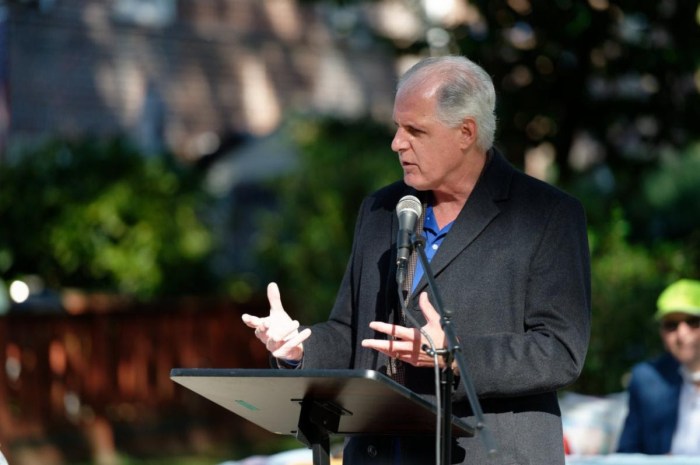A crowd estimated at 1,000 sang “Nearer My God to Thee” at the…
By Philip Newman
The 14 horse-drawn hearses had arrived at Lutheran Cemetery in Middle Village after a sorrowful journey from Manhattan’s Klein Deutschland (Little Germany) over the new Williamsburgh Bridge.
A crowd estimated at 1,000 sang “Nearer My God to Thee” at the Queens graveside. Many wept.
“As each coffin was lowered into the earth, these men and women asked themselves, ‘does it hide one of mine from me?’” The Times reporter suggested.
For in these coffins, buried in a common trench, were the remains of scores of unidentified mostly women and children who perished when fire swept the excursion boat General Slocum on June 15, 1904, killing 1,021 people.
The vessel caught fire as it steamed up the East River, carrying parishioners of St. Marks Evangelical Lutheran Church in a predominantly German neighborhood for an annual Sunday School picnic.
Little Germany was once the home of nearly 150,000 persons but after the Slocum calamity, thousands of persons of German descent began leaving the neighborhood, now called the East Village, for Yorkville in Upper Manhattan and other boroughs.
Not only the unidentified victims of the catastrophe are buried in what is now called Lutheran All Faiths Cemetery. In fact, nearly all the dead are interred at Lutheran Cemetery at Metropolitan Boulevard and 69th Street. Hundreds of funerals — as many as 112 in one day — followed in the days after the disaster.
The final resting place of the dead from the Slocum tragedy is marked by an elaborate monument dedicated June 15, 1905, a year after the disaster in an occasion attended by 10,000 people.
The memorial was built by Joseph Bermel, who later served as Queens borough president. The monument is surmounted by statues of the symbolic figures of Despair, Grief, Courage and Belief in the Hereafter. Into the marble base is carved a representation of the General Slocum in flames.
The event that ended in the worst maritime disaster in U.S. history began at 9 a.m. on a beautiful late spring morning at Third Street Pier on the East River.
As the General Slocum steamed upriver, its band played the Lutheran anthem, “Ein Feste Burg Ist Unser Gott” (A Mighty Fortress is Our God). Destination: Locust Grove on Eaton’s Neck on Long Island’s North Shore.
Fire of undetermined origin broke out in a storeroom as the boat neared Hell Gate but Capt. William Van Schaick, rather than beaching the vessel immediately, ordered full speed ahead to North Brother Island. The fire spread with calamitous results.
The celebrants died either in the flames or leaped overboard to drown as result of inability to swim or from being dragged to the bottom by life vests filled with rotted cork and lead weights.
In addition, the ship’s rotted fire hoses split and broke at every crease when the crew turned on the water.
Many women tossed children overboard lest they die in the onrushing flames.
After Van Schaick ran the ship aground on North Brother Island, medical personnel from Riverside Hospital for Infectious Diseases rushed out to give aid to those who suffered burns on the stricken ship. Police, fisherman and dock workers pulled scores of people from the water. Hundreds of the dead were laid out in rows on the grass of the island, the Brooklyn Eagle reported. Smaller boats recovered bodies from the river for two days.
“At noon, 16 of the remains of drowned women, clad in all the finery affected by the East Side for a day’s outing, lay in two ghastly rows on the floor of the main sitting room of the Alexander Avenue Police station,” the Eagle reported.
“In one corner were the corpses of six little children. All had been drowned.”
The bodies of several women were recovered with babies clasped tightly to their breasts, all badly burned.
“Great sympathy is expressed by the Queens Borough officials for William A. Richter of Long Island City, cashier for the tax office, who lost his wife and three children aboard the Slocum. Mr. Richter’s brother also lost his wife, two daughters and a son,” the Eagle reported.
Policeman Otto Veit of College Point lost his wife and child, and William Keisel of the Queens Building Bureau lost a niece, the Eagle said.
There were countless heroes that terrible day, including Capt. John McAllister, who ran his tugboat alongside the blazing boat and picked up at least 80 people from the river and then to the front of the Slocum, enabling dozens more to leap from the burning ship onto his vessel.
President Theodore Roosevelt ordered an investigation of the tragedy and German Kaiser Wilhelm II, leader of the former homeland of so many of the victims, sent a message of sympathy, as did several other world leaders.
In the end, the Knickerbocker Steamship Co., which owned the General Slocum, along with its executive officers — the safety inspectors responsible for assuring emergency facilities aboard the Slocum — and everyone else but the vessel’s skipper, Capt. Van Schaick, were exonerated. He was convicted of negligence and served five years in prison before he was pardoned by President William Howard Taft on Dec. 25, 1912.
Of the nearly 1,400 people aboard the General Slocum that fateful day, only one person is known to survive. Adella Wotherspoon, 99, of Watchung, N.J. attended a recent Queens observance of the Slocum disaster. Mrs. Wotherspoon was a babe in the arms of her mother, who suffered burns but survived. Two of the child’s older sisters did not.

































